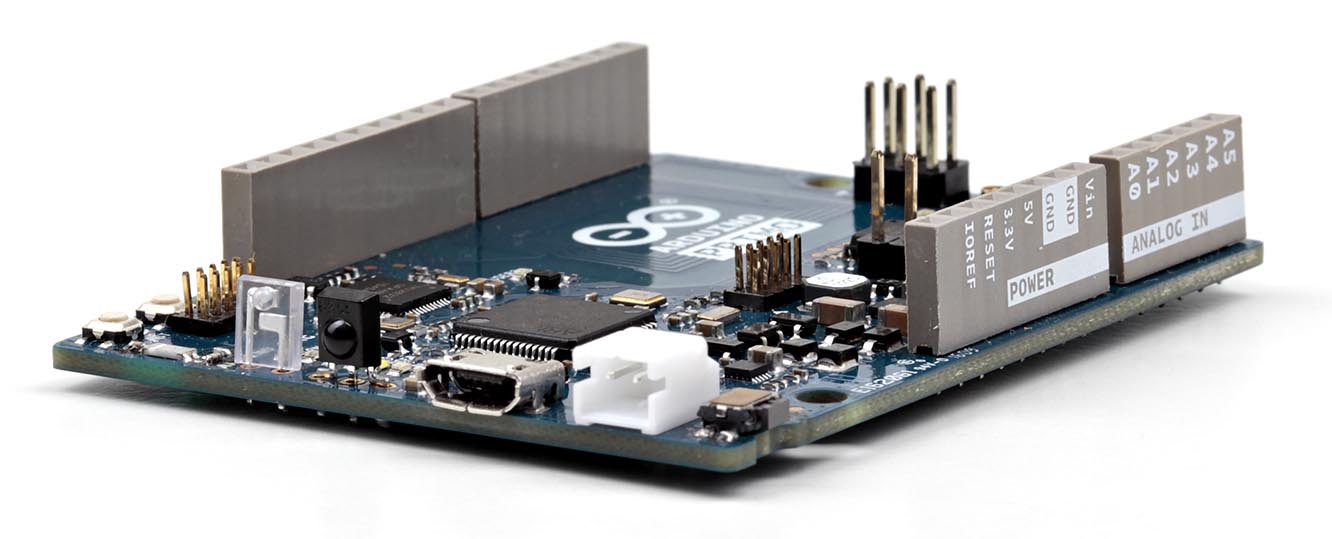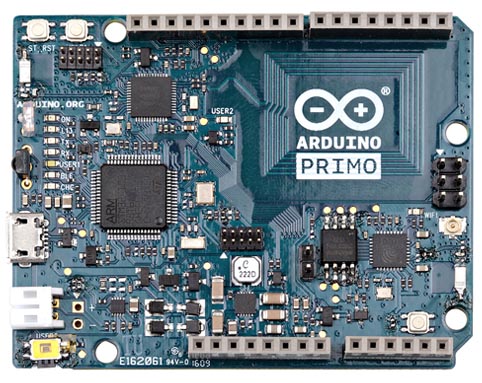The Arduino Primo integrates Bluetooth low energy, NFC Touch-to-Pair, Wi-Fi, and infrared connectivity, eliminating the cost and complexity of shields. IoT developers creating innovative applications now have built-in wireless connectivity all on one board.
Nordic Semiconductor announces that Arduino – the world’s most successful open-source ecosystem for education, Maker, and Internet of Things (IoT) markets – has specified the Nordic Semiconductor nRF52832 Bluetooth® low energy (previously known as Bluetooth Smart) System-on-Chip (SoC) at the heart of its latest product: a low cost IoT-targeted programmable single board computer (or ‘base board’) called the ‘Arduino Primo’.

The Arduino Primo base board features native Bluetooth low energy wireless connectivity and also includes Near Field Communication (NFC), Wi-Fi and infrared (IR) technologies. Previously users were required to add shields – plug-in daughter boards offering additional functionality – to the base board to upgrade to Bluetooth low energy wireless connectivity.
In addition to being able to wirelessly connect to a wide array of Bluetooth low energy sensors, the Arduino Primo can act as a fully-functional TCP/IP Internet client and server over Wi-Fi; uses the Nordic nRF52832 SoC’s integrated NFC for secure authentication and ‘Touch-to-Pair’ (a simple Bluetooth low energy pairing function requiring no user interaction), and has embedded IR for traditional remote control.

The Nordic Semiconductor nRF52832 features a 64 MHz, 32-bit ARM® Cortex™-M4F processor which delivers up to 60 percent more generic processing power compared to competing solutions, while offering ten times the Floating Point and twice the Digital Signal Processing (DSP) performance. The nRF52832’s 2.4 GHz multiprotocol radio is also fully compatible with the Bluetooth 4.2 specification and features -96 dB RX sensitivity and 5.5 mA peak RX/TX currents. The nRF52832 also features 512 kB Flash memory and 64 kB RAM, plus a fully-automatic power management system to optimize power consumption.
In addition to controlling the Bluetooth low energy RF protocol software (“stack”) and application code, the Nordic nRF52832 SoC’s ARM processor has ample computational overhead to supervise and control the Arduino Primo’s on-board accelerometer, temperature, humidity, and pressure sensors. For all but the most advanced projects, programming will be done via the established Arduino Integrated Development Environment (IDE) programming interface that Arduino says is designed to make electronics design easy for everyone regardless of experience, technical knowledge, and age.
Professional developers and Makers who want to access the most advanced features and functionality the Arduino Primo has to offer will also be able to use any Nordic nRF52 Series-compatible Software Development Kit (SDK) or programming tools. For example, the nRF5 SDK for IoT allows more experienced users to develop IPv6 over Bluetooth low energy applications on the nRF52832 SoC, enabling the Arduino Primo to communicate with other Internet-connected “things” without requiring the resources of a complex and expensive gateway such as a Wi-Fi router or smartphone.
“It has been estimated that the number of connected devices worldwide will increase from today’s approximately 15 billion to 200 billion in 2020,” says Federico Musto, CEO & President of Arduino S.r.L. “These numbers are astonishing, and mostly due to the crazy growth of the IoT. Makers, entrepreneurs, small and large companies, kids, and venture capitalists are paying close attention, and the playing field is very broad. From smart homes, to data analytics, to security, the applications are endless. Our passion at Arduino is to provide the hardware and software tools to encourage passionate people to build out their ideas and bring them into the world. Adding wireless connectivity from our partnership with Nordic provides even more options.
“Not only is the hardware of the Arduino Primo based on the Nordic nRF52 Series – one of the most popular Bluetooth low energy solutions on the market –but the software architecture and development tools make it simple for makers to get wireless up and running. Ease-of-use is one of our core strengths, and this makes the Nordic chip a perfect match for the Arduino Primo,” adds Musto.
“One of Nordic’s strategies is to closely support the maker and hobbyists communities so that they can painlessly incorporate Bluetooth low energy wireless connectivity into their electronic development projects,” comments Geir Langeland, Nordic Semiconductor's Director of Sales & Marketing. “Because Arduino-based electronics make up around 70 to 80 percent of amateur engineers’ projects, it was an easy decision when Arduino asked us to supply the nRF52832 SoC to form the heart of its first native Bluetooth low energy wireless base board. Considering the popularity of the Arduino ecosystem I predict it won’t be long before we see many innovative IoT applications using the Arduino Primo.”The Arduino Primo will shortly be complemented by the ‘Arduino Primo Core’, a wearables-targeted, 40 mm diameter circular base board form factor that offers all the functionality of the larger product with the exception of Wi-Fi.
